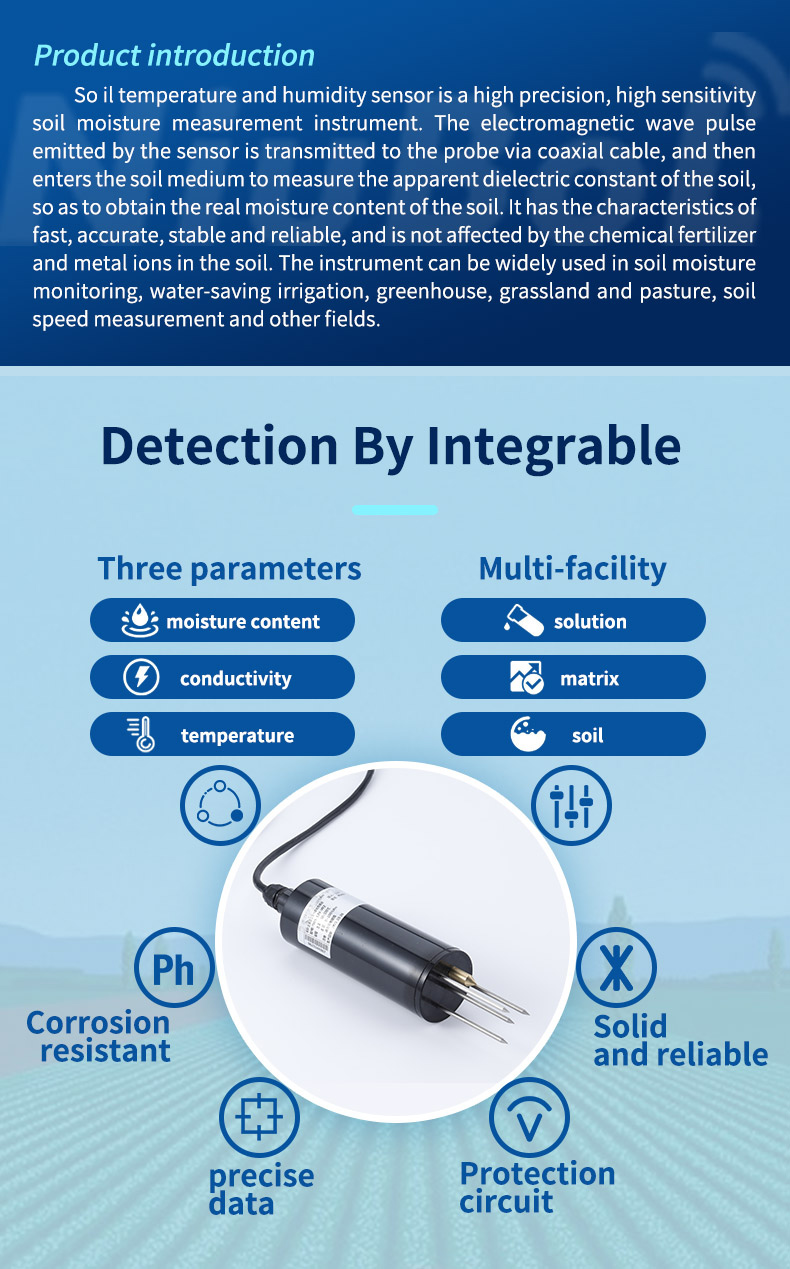

— Blogs —
—Products—
 Consumer hotline +8618073152920
Consumer hotline +8618073152920 WhatsApp:+8615367865107
Address:Room 102, District D, Houhu Industrial Park, Yuelu District, Changsha City, Hunan Province, China
Product knowledge
Time:2022-05-10 21:21:27 Popularity:734
Common Types of Soil Moisture Sensor Liquid Level Sensors
Regarding the common types of soil moisture sensor liquid level sensors, the main methods for measuring soil moisture on the market currently include neutron attenuation method, tensiometer moisture measurement method, and dielectric method speed measurement method. The neutron decay method measures soil water content.
Fast neutrons moving at high speed interact with matter to change direction and produce energy loss, turning into slow neutrons, resulting in attenuation. It is because the water contains hydrogen atoms, and the loss of neutrons to hydrogen atoms is much greater than the loss of other atoms. In this way, the soil water content can be determined by measuring slow neutrons, that is, the amount of attenuation in the measured substance can be determined. The amount of water content, the neutron soil moisture tester is designed based on this principle.
The advantage of this method is that it is accurate, but the important thing is that if this method is not well shielded, it is easy to cause radiation leakage, which will pollute the environment and endanger human health. Crop growth is closely related and obviously changes with changes in irrigation, rainfall, evaporation, etc. It is the most active part of soil moisture and needs real-time monitoring, which greatly limits the further promotion and application of neutron method. This method is widely used in developed countries. The surrounding home has been banned from using pressure sensors.
First, using the dielectric properties of soil to measure soil water content is also an effective, fast, simple and reliable method. For a capacitive humidity sensor with a certain geometric structure, its capacitance is proportional to the dielectric constant of the tested material between the two poles. Since the dielectric constant of water is much larger than that of general materials, when the moisture in the soil increases, the dielectric constant increases accordingly, and the capacitance value given by the humidity sensor also increases.
The corresponding relationship between the capacitance of the sensor and the soil moisture can measure the soil moisture. Capacitive humidity sensor is characterized by high precision, wide range, many types of materials that can be measured, and fast response speed, which can be used in online monitoring to realize automatic IJI pressure switch.

Second, the tensiometer-type soil moisture sensor is a sensor that is widely used successfully for certain soil moisture measurements. This instrument has a porous porcelain head, which is connected to the vacuum gauge through a water-filled tube.
The device is inserted into the borehole of the soil, the porous porcelain head is closely attached to the soil, and the vacuum gauge is set on the ground. The use of tensiometers to measure soil water content has been greatly developed. Its advantages are: the structure and principle are relatively simple, it can be measured online in real time, and the flow direction and penetration depth of water in the soil can be determined, but its shortcomings are also very prominent. Its measurement range is largely affected by soil quality.
For clay, due to its good aeration, even when the negative pressure of soil moisture is lower than 0-8Pa, the tensiometer can be used to measure the soil moisture content. What this method measures is the suction of soil water, which needs to be converted into soil water content according to the soil water characteristic curve. Because the relationship between soil water and energy is very complex, nonlinear, and easily affected by many soil physical and chemical properties, even for the same soil Field, this relationship is also very complicated, making it extremely difficult and inconvenient to use tension to estimate soil water content, resulting in large errors. This method suffers from hysteresis and loopback, which affect its measurement speed.
Related recommendations
Sensors & Weather Stations Catalog
Agriculture Sensors and Weather Stations Catalog-NiuBoL.pdf
Weather Stations Catalog-NiuBoL.pdf
Related products
 Combined air temperature and relative humidity sensor
Combined air temperature and relative humidity sensor Soil Moisture Temperature sensor for irrigation
Soil Moisture Temperature sensor for irrigation Soil pH sensor RS485 soil Testing instrument soil ph meter for agriculture
Soil pH sensor RS485 soil Testing instrument soil ph meter for agriculture Wind Speed sensor Output Modbus/RS485/Analog/0-5V/4-20mA
Wind Speed sensor Output Modbus/RS485/Analog/0-5V/4-20mA Tipping bucket rain gauge for weather monitoring auto rainfall sensor RS485/Outdoor/stainless steel
Tipping bucket rain gauge for weather monitoring auto rainfall sensor RS485/Outdoor/stainless steel Pyranometer Solar Radiation Sensor 4-20mA/RS485
Pyranometer Solar Radiation Sensor 4-20mA/RS485
Screenshot, WhatsApp to identify the QR code
WhatsApp number:+8615367865107
(Click on WhatsApp to copy and add friends)